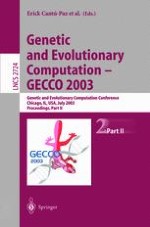2003 | OriginalPaper | Buchkapitel
Ramped Half-n-Half Initialisation Bias in GP
verfasst von : Edmund Burke, Steven Gustafson, Graham Kendall
Erschienen in: Genetic and Evolutionary Computation — GECCO 2003
Verlag: Springer Berlin Heidelberg
Enthalten in: Professional Book Archive
Aktivieren Sie unsere intelligente Suche, um passende Fachinhalte oder Patente zu finden.
Wählen Sie Textabschnitte aus um mit Künstlicher Intelligenz passenden Patente zu finden. powered by
Markieren Sie Textabschnitte, um KI-gestützt weitere passende Inhalte zu finden. powered by
Tree initialisation techniques for genetic programming (GP) are examined in [4],[3], highlighting a bias in the standard implementation of the initialisation method Ramped Half-n-Half (RHH) [1]. GP trees typically evolve to random shapes, even when populations were initially full or minimal trees [2]. In canonical GP, unbalanced and sparse trees increase the probability that bigger subtrees are selected for recombination, ensuring code growth occurs faster and that subtree crossover will have more difficultly in producing trees within specified depth limits. The ability to evolve tree shapes which allow more legal crossover operations, by providing more possible crossover points (by being bushier), and control code growth is critical. The GP community often uses RHH [4]. The standard implementation of the RHH method selects either the grow or full method with 0.5 probability to produce a tree. If the tree is already in the initial population it is discarded and another is created by grow or full. As duplicates are typically not allowed, this standard implementation of RHH favours full over grow and possibly biases the evolutionary process.
